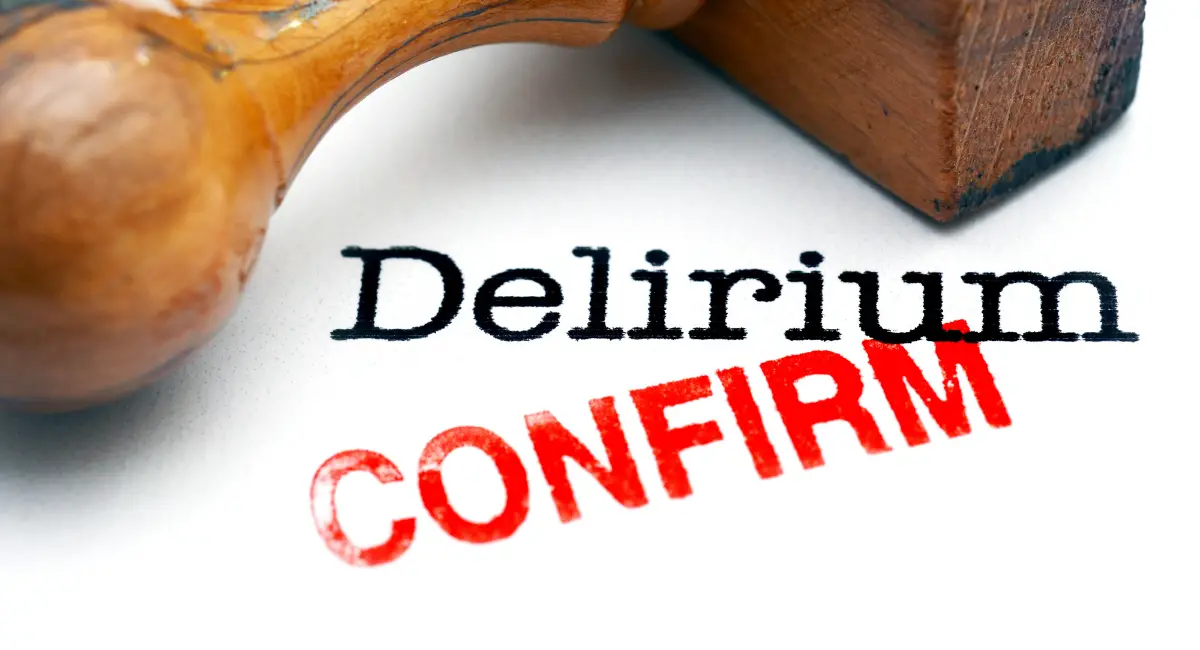
Delirium: Symptoms, Causes, and Therapy Options
Contents
Introduction
Delirium is an acute and often sudden change in mental status, characterized by confusion, disorientation, and impaired cognitive function. It is considered a Neurocognitive Disorder that results from an underlying medical condition or substance use. Unlike more gradual cognitive declines seen in dementia, delirium occurs rapidly and typically fluctuates in severity over the course of a day.
According to the Diagnostic and Statistical Manual of Mental Disorders, Fifth Edition (DSM-5), Delirium is classified as a Neurocognitive Disorder caused by various factors, including medical conditions, medication use, or substance withdrawal. The disorder can manifest in various settings, including hospitals, particularly in older adults or individuals with pre-existing cognitive impairment. This article explores the Symptoms, Causes, and Therapy Options for Delirium, focusing on Delirium Due to a Medical Condition and Substance-Induced Delirium.
Symptoms of Delirium
The symptoms of Delirium are generally cognitive, behavioral, and perceptual, with rapid onset and fluctuating severity. Below is a table outlining the common symptoms of Delirium and examples of how they manifest:
| Symptom | Description/Example |
|---|---|
| Confusion and Disorientation | The individual may become confused about time, place, or personal identity. For example, someone might suddenly forget where they are or not recognize familiar people. |
| Difficulty Focusing or Shifting Attention | The person may struggle to maintain focus on a conversation or task. For instance, they may become easily distracted or seem to drift in and out of awareness. |
| Altered Perception | The individual might experience hallucinations (seeing or hearing things that aren’t there) or have distorted perceptions of reality. |
| Memory Impairment | Short-term memory loss is common, with individuals having trouble remembering recent events or instructions. |
| Agitation or Restlessness | Some individuals with Delirium may become physically restless or agitated, while others may appear sluggish or lethargic. |
| Emotional Instability | Sudden mood swings or heightened emotional responses, such as anxiety, fear, or aggression, may occur without clear triggers. |
Types of Delirium
There are two primary types of Delirium, classified by their underlying causes: Delirium Due to a Medical Condition and Substance-Induced Delirium. Both types involve significant cognitive disturbances but differ in their origin and management.
1. Delirium Due to a Medical Condition
Delirium Due to a Medical Condition occurs when a sudden cognitive decline is triggered by an acute medical condition, such as infection, surgery, or organ failure. It is commonly seen in older adults, especially those with pre-existing medical issues or cognitive impairments. Hospitalized patients are particularly vulnerable to developing this type of delirium.
- Delirium is often linked to medical conditions that affect brain function, such as infections (e.g., urinary tract infections or pneumonia), metabolic imbalances (e.g., electrolyte disturbances), or post-surgical complications.
- Risk factors include age, cognitive impairment, underlying illnesses such as dementia, and hospitalization in intensive care units (ICUs).
Mary, an 82-year-old woman recovering from hip surgery, suddenly became disoriented and confused. She had trouble recognizing her family members and frequently asked where she was. The hospital staff diagnosed her with Delirium Due to a Medical Condition caused by post-surgical complications.
2. Substance-Induced Delirium
Substance-Induced Delirium is caused by the acute effects of substances, including drugs, alcohol, or withdrawal from these substances. It can occur during intoxication, as a result of overdose, or during the withdrawal process. This type of delirium is especially common in individuals with a history of substance use disorder or those undergoing medical treatment involving sedatives or anesthetics.
- Substance-Induced Delirium occurs when the brain’s normal functioning is disrupted by the effects of intoxicants or withdrawal from them. Substances such as alcohol, benzodiazepines, or illicit drugs can cause delirium by altering neurotransmitter levels in the brain.
- Delirium tremens is a severe form of alcohol withdrawal delirium marked by confusion, hallucinations, tremors, and seizures. It often requires emergency medical treatment due to its potentially life-threatening nature.
John, a 45-year-old man with a history of heavy alcohol use, experienced confusion, tremors, and visual hallucinations after abruptly stopping drinking. He was diagnosed with Substance-Induced Delirium due to alcohol withdrawal.
Causes and Risk Factors of Delirium
The development of Delirium is influenced by a combination of medical, genetic, and environmental factors. Identifying the underlying causes is essential for appropriate treatment.
Major causes that we will discuss, include: Medical Conditions and Surgery, Substance Use and Withdrawal, Environmental and Age-Related Factors
1. Medical Conditions and Surgery
Acute medical conditions such as infections, organ failure, dehydration, or metabolic imbalances are common causes of Delirium. Surgical procedures, particularly those involving general anesthesia, can also trigger delirium, especially in older adults.
- Delirium may arise from infections like urinary tract infections or pneumonia, which are particularly common in elderly patients. Other medical conditions, including electrolyte imbalances, hypoxia (low oxygen levels), or kidney or liver failure, can also impair brain function and lead to delirium.
- Post-surgical delirium is a common complication in older patients, especially after major surgeries like hip replacements or heart bypass surgery. The effects of anesthesia, pain medications, and physical stress on the body can contribute to its onset.
Tom, a 76-year-old man, developed Delirium following a heart bypass surgery. His medical team discovered that electrolyte imbalances and pain medications had contributed to his confusion and agitation.
2. Substance Use and Withdrawal
The use of substances such as alcohol, sedatives, or stimulants, as well as withdrawal from these substances, can trigger Delirium. This type of delirium is particularly dangerous in individuals with substance use disorders, as severe withdrawal can lead to life-threatening complications like seizures.
- Substances like alcohol, benzodiazepines, and opioids depress the central nervous system, altering brain function and causing delirium when used in excess or during withdrawal. Alcohol withdrawal delirium, or delirium tremens, is the most severe form, characterized by confusion, hallucinations, and autonomic instability.
- Stimulants like methamphetamine or cocaine can also induce delirium during acute intoxication, causing agitation, paranoia, and hallucinations.
John, who abruptly stopped using benzodiazepines after years of regular use, began experiencing severe agitation, confusion, and visual hallucinations. He was diagnosed with Substance-Induced Delirium related to benzodiazepine withdrawal.
3. Environmental and Age-Related Factors
Certain environmental factors and demographic characteristics, such as age, frailty, and prolonged hospitalization, increase the risk of Delirium. Older adults and individuals with pre-existing cognitive impairments, such as dementia, are at higher risk.
- Hospitalized older adults, especially those in intensive care units (ICUs), are at increased risk of developing delirium due to a combination of physical stress, unfamiliar environments, and disruptions in sleep patterns. Sedative medications and prolonged hospital stays contribute to the risk.
- Delirium is common in individuals with pre-existing conditions like dementia, as their brains are more vulnerable to changes in neurotransmitter levels, oxygen supply, or blood flow, all of which can trigger confusion and cognitive decline.
Sarah, an 85-year-old woman with dementia, became disoriented and agitated during a hospital stay following a fall. The unfamiliar environment and her physical stress contributed to her development of Delirium.
Therapy and Treatment Options for Delirium
Effective treatment for Delirium involves addressing the underlying causes, managing symptoms, and providing supportive care. Below are key therapy and treatment options for Delirium.
1. Identifying and Treating the Underlying Cause
The primary treatment for Delirium is identifying and addressing the underlying medical or substance-related cause. Once the cause is managed, delirium symptoms often improve.
- In cases of Delirium Due to a Medical Condition, treatment focuses on managing the triggering medical issue, such as treating infections with antibiotics, correcting electrolyte imbalances, or improving oxygen levels. Medical interventions such as IV fluids, nutritional support, or oxygen therapy may be required.
- For Substance-Induced Delirium, the treatment approach depends on whether the delirium is caused by intoxication or withdrawal. In cases of withdrawal, medications like benzodiazepines or antipsychotics may be used to manage withdrawal symptoms and prevent complications.
Mary, diagnosed with Delirium Due to a Medical Condition, received immediate medical intervention to address the underlying causes of her delirium. Delirium is a temporary state of confusion and altered consciousness, often triggered by factors such as infections, dehydration, or metabolic imbalances.
2. Cognitive and Behavioral Interventions
Non-pharmacological interventions such as cognitive support, environmental modifications, and behavioral management can help reduce delirium symptoms and support recovery.
- Cognitive interventions include reorienting the patient to time, place, and person through regular communication and familiar objects. This can involve providing calendars, clocks, and family photos to reduce confusion.
- Environmental modifications, such as reducing noise, providing adequate lighting, and maintaining a consistent daily routine, help prevent delirium or minimize its severity in hospital settings.
Sarah’s caregivers took several important steps to help manage her confusion and agitation during an episode of delirium, a condition often characterized by sudden cognitive changes, including confusion, disorientation, and difficulty concentrating. In Sarah’s case, the caregivers focused on creating a comforting and familiar environment to help reduce the symptoms of delirium.
3. Pharmacotherapy
Medications are sometimes used to manage the symptoms of Delirium, particularly in cases of severe agitation or hallucinations. However, pharmacological treatment is generally considered a last resort due to the risk of side effects, especially in older adults.
- Antipsychotics such as haloperidol or quetiapine may be prescribed to manage severe agitation, hallucinations, or aggression in individuals with Delirium. These medications help stabilize the individual’s behavior while addressing the underlying cause.
- Benzodiazepines are used in cases of Substance-Induced Delirium related to alcohol or sedative withdrawal to prevent seizures and manage anxiety. However, they are generally avoided in other forms of delirium due to the risk of worsening confusion.
John, diagnosed with Substance-Induced Delirium due to alcohol withdrawal, was prescribed benzodiazepines as part of his treatment to help manage the symptoms associated with withdrawal and prevent potential complications. Alcohol withdrawal can lead to a range of symptoms, including confusion, agitation, tremors, and in severe cases, seizures.
Long-Term Management of Delirium
Long-term management of Delirium focuses on preventing future episodes, especially in individuals with chronic medical conditions or a history of substance use. Key strategies for long-term management include:
- Managing Underlying Conditions: Proper treatment and management of chronic medical conditions, such as dementia or cardiovascular disease, reduce the risk of future episodes of Delirium.
- Substance Use Management: Individuals with substance use disorders benefit from ongoing treatment and relapse prevention strategies to avoid future episodes of Substance-Induced Delirium.
- Cognitive Support: Ongoing cognitive support and environmental modifications in hospital or care settings help prevent confusion and cognitive decline in high-risk individuals.
Conclusion
Delirium is an acute and often reversible cognitive disorder characterized by confusion, disorientation, and impaired thinking. The causes of Delirium include medical conditions, substance use, or withdrawal, with risk factors such as advanced age and hospitalization. Treatment typically involves addressing the underlying medical cause, providing cognitive and behavioral interventions, and, in some cases, using medications to manage symptoms. Long-term management strategies, such as managing chronic conditions and cognitive support, are essential for reducing the risk of future episodes and improving the quality of life for individuals affected by Delirium.
References
- American Psychiatric Association. (2013). Diagnostic and statistical manual of mental disorders (5th ed.). American Psychiatric Publishing.
- Inouye, S. K., van Dyck, C. H., Alessi, C. A., Balkin, S., Siegal, A. P., & Horwitz, R. I. (2006). Delirium in elderly patients: A clinical review. JAMA, 294(20), 2539-2547.
- Maldonado, J. R. (2008). Delirium in the acute care setting: Characteristics, diagnosis, and treatment. Critical Care Clinics, 24(4), 157-172.
- Hshieh, T. T., Yang, T., Gartaganis, S. L., & Inouye, S. K. (2015). Hospital elder life program: Reducing delirium in older patients. Journal of the American Geriatrics Society, 63(3), 506-511.
- Meagher, D. J. (2001). Delirium: Optimizing management. BMJ, 322(7279), 146-147.
- Ely, E. W., Shintani, A., Truman, B., Speroff, T., Gordon, S. M., & Harrell, F. E. (2004). Monitoring sedation status over time in ICU patients: Reliability and validity of the Richmond Agitation-Sedation Scale (RASS). Journal of the American Medical Association, 291(11), 1390-1397.
- Fong, T. G., Tulebaev, S. R., & Inouye, S. K. (2009). Delirium in elderly adults: Diagnosis, prevention, and treatment. Nature Reviews Neurology, 5(4), 210-220.
- Marcantonio, E. R. (2017). Delirium in hospitalized older adults. New England Journal of Medicine, 377(15), 1456-1466.
- Pandharipande, P. P., Girard, T. D., Jackson, J. C., Morandi, A., & Thompson, J. L. (2013). Long-term cognitive impairment after critical illness. New England Journal of Medicine, 369(14), 1306-1316.
- van den Boogaard, M., Slooter, A. J., van der Kooi, A. W., & Zandstra, D. F. (2012). The impact of delirium on clinical outcomes in critically ill patients. Intensive Care Medicine, 38(1), 12-19.
Explore Other Mental Health Issues








